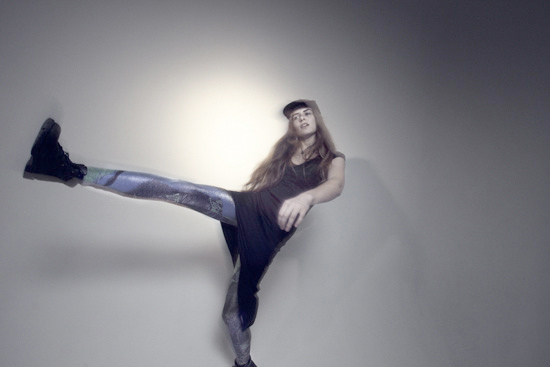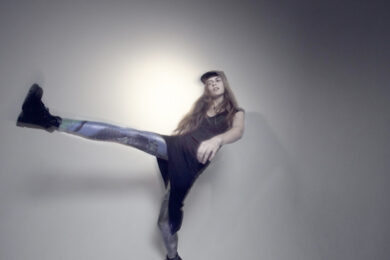Several months after its release, Laurel Halo’s Quarantine remains one of this year’s most intriguing and divisive listens. A departure from the warmer and more organic feel of her earlier work, it found her unprocessed vocals set in an unnaturally synthetic sound world, with its imperfections physically straining against the glossy high-definition of its surroundings.
In our review we said: "It’s rare indeed to hear a song-based artist delving deep, as Halo does here, into the Thomas Köner/Porter Ricks/Christian Fennesz school of intricate sound design, careful layering and illusion of infinite depth. The results are nothing short of magnificent, producing a set of tracks whose fizzing surfaces are always disturbed by some new action just beneath, where ridges of static ruffle and tumble over one another, and where harsh regions of higher density sluice violently into the foreground. Mood is determined by topography: when the terrain is rough and craggy, as in many places during the album’s second half, her voice responds in kind, varying in confidence or slipping into the background."
In the time period since the album’s release Halo has been touring and reworking its content live, and she’s now on an audiovisual tour of the UK and Europe accompanied by visual work by Tom Scholefield (aka Konx-Om-Pax). You can watch a trailer for the tour below, and for the full list of tour dates, scroll to the bottom of the page.
Laurel Halo: 2012 European Tour Trailer from Hyperdub on Vimeo.
The original tour announcement included a date at London’s Plastic People on November 21st – that show has now sold out, but an additional date has been booked for November 20th (tickets are available here). Quietus favourite The Haxan Cloak will be in support on both dates.
Given that her music is an entity continually in flux – her live shows in the UK this summer, while highly dependent on the properties of the venue, found the Quarantine material changing shape and largely outweighed by the grainy dance rhythms of earlier releases Spring and Hour Logic – we dropped Halo a line to ask about live performance, and how her newer music has been taking shape in the time period since her debut album’s release.
I wanted to start off by asking about your audiovisual work with Tom Scholefield. Is the idea of touring your music with accompanying visuals something you’ve been interested in for a while? What is it about Tom’s work that made you think he’d be a particularly good person to work with?
Laurel Halo: I’ve been wanting to do visuals with my set for a while, and I’ve been into Tom’s work for ages too. There’s a lot of digital melt cross-pollination between his visual work and my music.
Was there a lot of dialogue and creative feedback around the visual aspect between you two? Did you have quite strong ideas of the sort of mood/feel you wanted the visuals to have?
LH: I wrote down some brief ideas and vignettes for Tom to vibe off of. Looking at these titles now they’re pretty stony, like ‘Radio Moles – Stroboscopic Partymangle’, ‘Enforced Geometry to CREMIND’, ‘Despair and Multiplicity leading to COLD, ESCAPE FRESH WINTER’, ‘The Plastics Forest’. I didn’t have any hard instructions, just some brief written sketches for him to do what he wanted with.
What do you think the visual aspect brings to your music? Was the intention to make certain ideas or themes within what you’re doing more explicit?
LH: It wasn’t necessarily to enforce a vibe, but I did ask him to make some throbbing amoebas in a ‘peaceful Akira’ vein though, haha.
How have you found the process of moving Quarantine‘s tracks into the live performance arena? They obviously require a lot more of your vocal presence than some of your earlier music – has it been odd or nerve wracking singing live more?
LH: It’s weird, because you’d think the recording to live process would be linear, but I don’t sing that often when I play, the live set is more rhythmically oriented than anything, as it has been since the beginning. I usually try to sing two songs from the record when I play live, but I often do purely instrumental sets. I don’t enjoy seeing photos of myself holding a microphone because I feel like a jerk, and a lot of the lyrics from Quarantine I don’t want to go back to – they came from a hard place. Singing is a private thing most of the time and I was drawn to it because I had to mire around in the shit for a while with that record, but it might not always be that way. It’s tricky too because the Quarantine tracks were so crafted and edited, it’s almost the opposite to how I play, where I like to build tracks differently every night.
How have responses been on the whole to Quarantine since its release? People I know seem to have either fallen madly in love with it or not quite figured out how to take it. Have people on the whole seemed to understand what you were trying to achieve with it?
LH: I’m not quite sure how to answer this one, but I’m glad that some people got into it. The record’s not meant for everyone, it’s not a pop record in the slightest so I think people expecting that would be disappointed by the vocal tone and production approach. To me the bleak and raw was key, and I think people that have been heartbroken maybe get the record more.
It was interesting hearing you bringing more four-to-the-floor into your live performances this summer, it worked nicely as a driver underneath all the surface haze. Have you been working on writing and recording more dancefloor-leaning music recently? Does working with rhythm in such a direct way offer a different set of opportunities and challenges than, say, what you were doing with Quarantine, which felt like you were often trying to squash the rhythm out of the beat grid entirely?
LH: The answer is yes – this most recent iteration of the live set is purely hardware, and it’s been fun putting together live tracks that I can tweak and arrange on the fly. I like music that makes you move, it’s equally cathartic as a heart on the sleeve recording process, but in a way it’s dumber, it’s less a heavy theoretical or emotional play as it is just making primal music. I run on the more anxious side, so writing rhythmic music is a way of letting go and elevating above the noise. You can still address the heavy and dark but turn it inside out.
Does the process of writing music that might largely be performed live, rather than laid down on record, differ a lot from your process of recording studio material? Do you experience different pressures and priorities for each? One thing you mentioned in the interview we did earlier this year was that "in the future I want to make music that’s coming from a live performance aspect, because this record was a process of jamming and then arranging and editing, and it would be nice to make music that’s completely organic in the spontaneous performance kind of way, so I anticipate future music going harder in this direction." Is that something you’ve had the chance to work towards yet?
LH: Yeah, putting together this new live set is going in that direction, I’m more into playing hardware live now where before I’d record parts on a number of instruments and then do endless detail work. We’ll see how the live set material translates to recordings, I’m sure my freaker brain will still go off on the minutiae but hopefully it will involve way less editing, which is probably my least favorite part of making music.
When we spoke earlier in the year, you talked about the way you used your voice on Quarantine as "less about having a cold relationship with gear than it is to do with the unease of being human in a synthetic environment." That’s something I’ve been thinking a lot about since – was that a particular idea you set out to explore on Quarantine – the unsettling aspects of our increasingly symbiotic relationships with the everyday digital technology we’re bound to?
LH: In retrospect I’m not sure if the synthetic environment I mentioned applies to just being technology bound, because that is inevitable and pretty everyday. There are many types of synthetic environments, whether digital, psychological, physical, etc. I don’t think the human-digital strain is a high concept by any means, and I wasn’t trying to make a concept record with Quarantine. Getting on the plane at JFK the other day I saw one of those HSBC ads that said ‘in the future, your DNA will be your data’ and all I could think was, isn’t that already the case? It’s just some happy marketing pills for dumbasses that go ‘oh really? I had no idea!’.
Have you heard the new record by Holly Herndon, which is coming out on RVNG Intl in a few weeks? (listen to a track here) She seems to be concerned with a similar set of ideas around the uneasy relationships between our bodies and minds and the airlessness of the digital world we spend so much time involved with – it’s largely made up of her own voice and breathing, processed so that it pixellates at the edges and breaks up. Do you think these are particularly important or relevant topics to be examining at this current point in time?
LH: Yeah, Holly’s music is amazing, almost by accident we met last fall in San Francisco and spent a weekend together and it was great getting to know her. I find there’s a common thread between her record and Gatekeeper’s Exo in that they both address this hi-def, super sheen technology as the be-all feeling. I love that she does everything live too, the vocal processing, it’s so sick that she can get deep in that Max MSP world and come out the other side with felt as opposed to purely academic music. In terms of the importance or relevance of music responding to digitalia I can’t say, I don’t think my opinions should be taken too seriously.
Laurel Halo will be playing the following dates:
OCTOBER
25th – Body Tonic, Dublin, Ireland
26th – Stereo, Glasgow, UK
27th – Sneaky Petes, Edinburgh
30th – Bad Bonn, Düdingen, Switzerland
31st – Palace, St.Gallen, Switzerland
NOVEMBER
2nd – Rewire Festival, den Hague, Netherlands
3rd – L’Mono, Bilbao, Spain
4th – Nave de Musica, Matadero, Madrid, Spain
8th – Circolo degli Artisti, Rome, Italy
9th – Club2club, Turin, Italy
10th – Musicbox, Lisbon, Portugal
20th – Plastic People, London (w/ The Haxan Cloak)
21st – Plastic People, London (w/ The Haxan Cloak)



